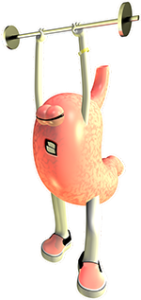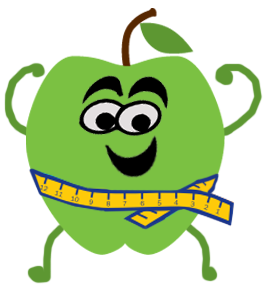Body Composition
 What is it?
What is it?
At the body composition station, we determine weight, height, waist circumference, body mass index (BMI) and body fat percentage. All five measures tell us something different and can be used together as an overall indication of a person’s body size and composition. For example:
Weight can change a lot simply based on a person’s height.
BMI is a number calculated from a person’s weight and height. It provides an indicator of body fatness and is the most commonly used body composition measure to screen for weight categories that may lead to health problems. BMI doesn’t take into account muscle mass (which weighs more than fat), so some athletic individuals can have larger BMIs for this reason.
Body fat percentage is used instead of BMI to determine body fatness. It used to be measured using calipers, but now is often calculated using special scales that send a very small electrical current through the body (bioimpedance). It provides a reliable measure of body fatness, though it is difficult to measure in most situations since it requires specialized equipment. This is why BMI is used more frequently.
Waist circumference provides a measurement of weight around our mid-sections. Extra size in this region has been linked to chronic health problems.
How is it measured?
 Trained community volunteers help us measure height, weight, body mass index, body fat percentage and waist circumference. Height is measured using a stadiometer (a height stick) in inches, to the nearest half inch. Weight, body mass index, and body fat percentage are measured using a digital Tanita bioimpedence scale (TBA 300A) with precision within 0.2 lb (0.1 kg). Before February 2012, Tanita measures were hand-entered into the computer by a trained volunteer at the time of the measurement. Since February 2012, the Tanita measures from the Tanita have been automatically sent to the Let’s Get Healthy! database using the Tanita’s RS-232 integrated port. Waist circumference measured by a tape measure at the umbilicus (belly button) and is hand-entered. Recommendations and feedback are gender and age-dependent. The body composition station is available for the following audience and takes approximately:
Trained community volunteers help us measure height, weight, body mass index, body fat percentage and waist circumference. Height is measured using a stadiometer (a height stick) in inches, to the nearest half inch. Weight, body mass index, and body fat percentage are measured using a digital Tanita bioimpedence scale (TBA 300A) with precision within 0.2 lb (0.1 kg). Before February 2012, Tanita measures were hand-entered into the computer by a trained volunteer at the time of the measurement. Since February 2012, the Tanita measures from the Tanita have been automatically sent to the Let’s Get Healthy! database using the Tanita’s RS-232 integrated port. Waist circumference measured by a tape measure at the umbilicus (belly button) and is hand-entered. Recommendations and feedback are gender and age-dependent. The body composition station is available for the following audience and takes approximately:
- Adults (English, Spanish, Chinese, Vietnamese and Korean) – Takes 3-5 minutes
- Kids (English, Spanish, Chinese, Vietnamese and Korean) – Takes 3-5 minutes
How we determined the categories?
Body composition recommendations depend greatly on gender and age — changing every month until the age of 20! These recommendations come primarily from the Centers for Disease Control (CDC) and are used by most doctors’ offices.
Weight and Height averages are displayed. These averages can be compared to the percentiles from the Centers for Disease Control (CDC) based on age. Since percentiles change based on month, we used the upper month limit for that age. For example, if a 10 year old girl was measured, we would provide her for recommendations for a 10 year, 11 month old girl.
Body Mass Index is categorized using age- (by year and 11 months) and gender-appropriate cut points for underweight (< 5th percentile), normal (5th -less than 85th), overweight (85th-95th) and obese (greater than 95th percentile).
Child (<20 years) BMI Recommendations
Body Fat Percentage recommendations for adults and children at our events come from the Tanita site. For our publications, there are currently no accepted guidelines for excess percent body fat in adolescents; therefore, we follow the procedure implemented by Freedman et al. where excess body fat is based on the percent of adolescents with a BMI at or above the CDC cutpoint for obese. For example, in our study sample, if 12% of girls and 15% of boys were categorized as having BMI-defined obesity, then excess body fatness for this analysis would defined as a percent body fat greater than or equal to the age-specific 88th percentile of body fat for girls and the 85th percentile of body fat for boys.
Waist circumference recommendations for adults are <35 inches for women and <40 inches for men. There are no existing standard cut points for waist circumference in adolescents, so our publications determine the gender- and age-specific mean waist circumference and dichotomize (split into two groups) at the mean for our analyses.
Where to get more information…
The CDC has a beautiful website about weight regulation, including information and tips for attaining or maintaining a healthy body composition.
Research Bibliography
- Freedman DS, Wang J, Maynard LM, et al. (2005) Relation of BMI to fat and fat-free mass among children and adolescents. Int J Obes (Lond) 29, 1-8.
- Freedman DS, Wang J, Thornton JC, et al. (2008) Racial/ethnic differences in body fatness among children and adolescents. Obesity (Silver Spring) 16, 1105-11.
- Mei Z, Grummer-Strawn LM, Pietrobelli A, et al. (2002) Validity of body mass index compared with other body-composition screening indexes for the assessment of body fatness in children and adolescents. Am J Clin Nutr 75, 978-85.



